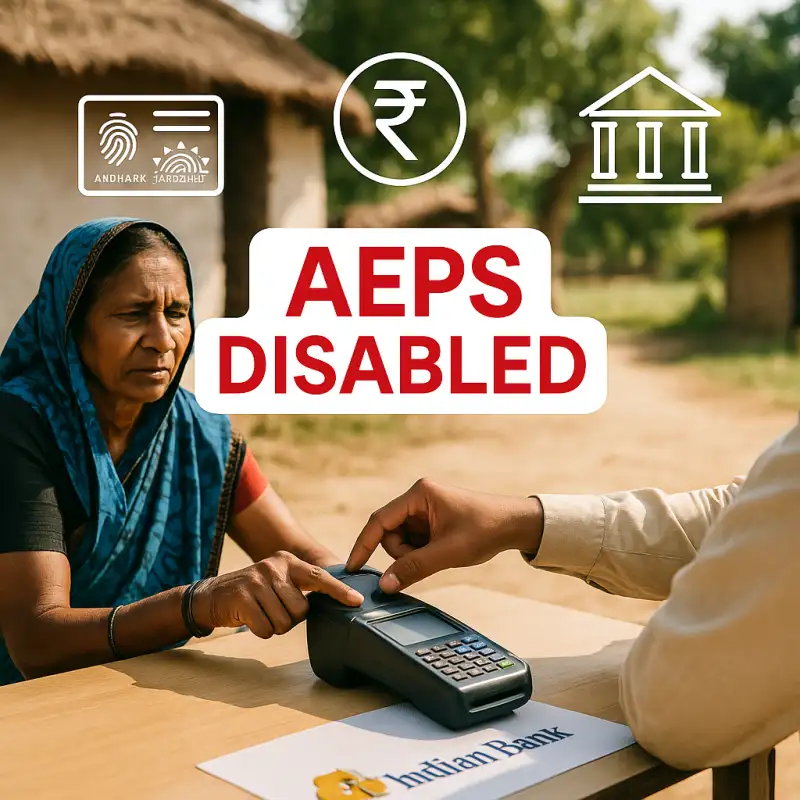
AEPS Debit Facility Disabled: Meaning, Reasons
AEPS Debit Facility Disabled in Indian Bank – Meaning, Reasons & Solution
The AEPS (Aadhaar Enabled Payment System) has revolutionized banking access across India, especially for people in rural and remote regions. With just an Aadhaar number and biometric authentication, users can perform basic banking transactions without needing traditional banking infrastructure.
However, many users—especially Indian Bank customers—have recently reported encountering the message: "AEPS debit facility disabled."
In this article, we'll explain the meaning of this message, the reasons behind it, its impact, and how to resolve the issue.
What Is AEPS Debit Facility?
The AEPS debit facility allows bank customers to:
- Withdraw cash
- Perform balance inquiries
- Transfer funds
All using their Aadhaar number and biometric verification (usually fingerprint).
These transactions are carried out through micro-ATMs operated by Banking Correspondents (BCs) and do not require a debit card, PIN, or internet.
What Does AEPS Debit Facility Disabled Mean?
The message "AEPS debit facility disabled" means that your bank account is currently not allowed to carry out AEPS debit transactions, such as:
- ❌ Cash withdrawals via Aadhaar
- ❌ AEPS-based fund transfers
- ✅ Receiving money (credits) is still allowed
So, while incoming payments work, you can’t withdraw or send money using AEPS until reactivation.
AEPS Debit Facility Disabled – Meaning Explained
To summarize:
- Your Aadhaar-based debit transactions are blocked
- Your bank account remains active (usable via ATM, mobile app, net banking)
- The restriction applies only to AEPS debit services
This is typically a compliance or security measure, not a sign of fraud or account suspension.
Why Is the AEPS Debit Facility Disabled?
Here are some common reasons, especially with Indian Bank:
1. Inactivity
If you haven’t used AEPS for over 12 months, the bank may auto-disable the debit feature as a security protocol.
2. NPCI Guidelines
The National Payments Corporation of India (NPCI) advises banks to disable AEPS debit access for:
- Dormant AEPS users
- Accounts with only AEPS withdrawals (possibly suspicious usage)
3. Security Concerns
If your account shows unusual activity or fraud risks, AEPS debit may be temporarily disabled.
4. Aadhaar Linking or Biometric Failures
If your Aadhaar is not properly linked to your account, or if biometric authentication fails repeatedly, AEPS services may be restricted.
5. Regulatory Restrictions
At times, banks suspend AEPS services due to RBI or government mandates.
AEPS Debit Facility Disabled in Indian Bank
Indian Bank customers commonly report this issue, especially:
- Those who haven’t used AEPS in over 12 months
- Accounts flagged for only AEPS withdrawals
- Scholarship or beneficiary accounts with low AEPS activity
Impact on Users:
- ❌ Cannot withdraw using Aadhaar and fingerprint
- ✅ Can still use debit card, net banking, mobile app, and receive money
This can be a major challenge in rural areas where AEPS is the primary method of accessing cash.
How to Reactivate AEPS Debit Facility in Indian Bank
Follow these steps to fix the issue:
Step 1: Visit Your Home Branch
Go to your Indian Bank branch and request reactivation of the AEPS debit facility.
Step 2: Carry Required Documents
Bring:
- Aadhaar card
- Bank passbook
- Other valid ID if required
Step 3: Unlock Aadhaar Biometric (If Locked)
If your Aadhaar biometric is locked, unlock it via the UIDAI portal before visiting the bank.
Step 4: Perform a Test Transaction
After reactivation, try a simple AEPS transaction (e.g., balance inquiry) to confirm it’s working.
Step 5: Use AEPS Regularly
To avoid future deactivation, use AEPS at least once every 12 months.
Key Points to Remember
- AEPS debit disabled ≠ Account frozen
- Other services (ATM, net banking) still work
- Deactivation is usually for security or regulatory compliance
- Regular AEPS usage helps keep the facility active
Final Thought
The AEPS debit facility is a crucial lifeline for millions, especially in rural India. If you see the message “AEPS debit facility disabled”, especially as an Indian Bank customer, it’s likely due to inactivity or policy rules from NPCI.
Fortunately, reactivation is simple—just visit your branch, provide necessary documents, and resume AEPS usage.
Tip: Set a reminder to use AEPS at least once every 6–12 months if you rely on it regularly.
Have you experienced this issue? Feel free to ask questions or share your experience in the comments — we're here to help!


